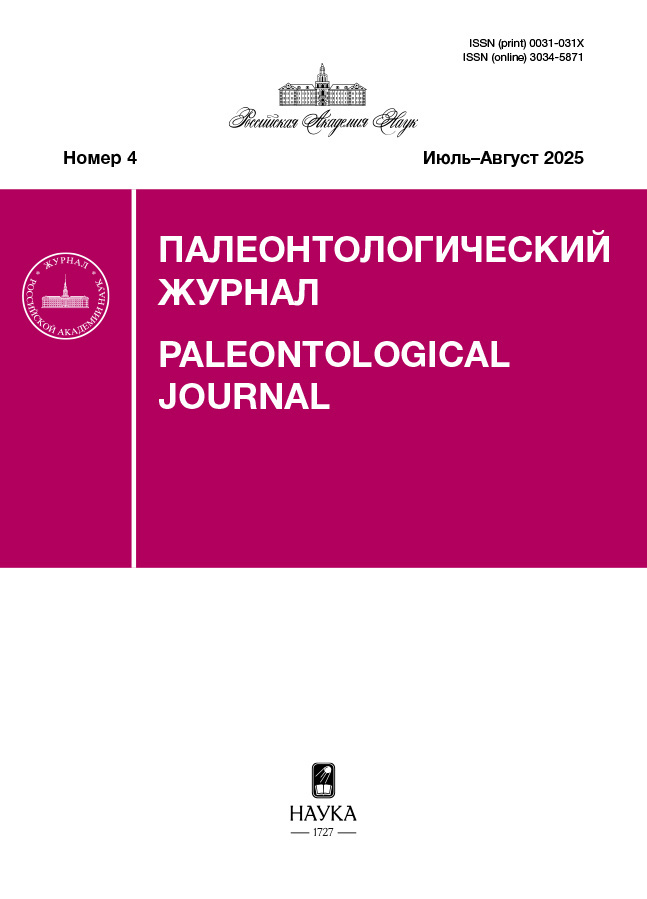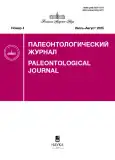Paleontologičeskij žurnal
ISSN (print): 0031-031X
Media registration certificate: No. 0110202 dated 02/05/1993
Founders: Paleontological Institute named after. A.A. Borisyak RAS, Russian Academy of Sciences
Editor-in-Chief: Rozanov Alexey Yurievich
Number of issues per year: 6
Indexation: RISC, list of Higher Attestation Commissions, CrossRef, White List (level 3)
The journal is published 6 times a year in Russian and English languages. The name of the English version is Paleontological Journal.
The journal is presented in many databases, including the Web of Science, Scopus and RSCI.
Current Issue
No 4 (2025)
Revision of the family Tetrentactiniidae Kozur et Mostler, 1979 (Radiolarians of the Late Paleozoic). Part 2. New genera and species
Abstract
New genera and species of radiolarians of the family Tetrentactiniidae Kozur et Mostler, 1979, rev. et emend. Afanasieva et Gainullina, 2025 are studied from the Lower Carboniferous (Mississippian) deposits of the Volga-Ural Basin and the Lower Permian (Cisuralian) sections of the South Urals. Two new genera, Longibelona gen. nov. and Tetraedrella gen. nov., are established, and five new species of radiolarians are described: Longibelona globosa sp. nov., L. alia sp. nov., L. neglecta sp. nov., Tetraedrella tetraedros sp. nov., Uralitina brevispina sp. nov. An extended description of the genus Uralitina and the species U. megalospina Afanasieva et Gainullina, 2025 is provided.
Paleontologičeskij žurnal. 2025;(4):3-19
 3-19
3-19


Ammonoids from the Beleutian regional substage (Lower Carboniferous) of Central Kazakhstan
Abstract
The ammonoid fauna from the stratotype section of the Beleutian Regional Substage in the Beleuty River basin in the Ulytau Region of Central Kazakhstan is studied. For the first time, the locality details and precise level of the ammonoid occurrence marking the base of the Beleutian Regional Substage in the stratotype section of terrigenous-carbonate Beleuty Formation are documented. The composition of the assemblage indicates the lower Serpukhovian Uralopronorites–Cravenoceras Genozone, but probably not its base. A new species of the genus Cravenoceras is described.
Paleontologičeskij žurnal. 2025;(4):20-37
 20-37
20-37


 38-45
38-45


Some silurian ostracodes of Mongolia
Abstract
The results of the study of ostracods from sediments of the Chargat Formation (Lower Silurian, Llandovery) and the middle part of the Tsagaanbulag Formation (Upper Silurian, Ludlow) are presented for the first time for Mongolia. Brief characteristics of the localities where ostracod remains of this age have been found are given, as well as descriptions and images of shell crustaceans belonging to the genera Khandianella Melnikova, gen. nov., Chargatanella Melnikova, gen. nov., Hemsiella Martinsson, 1962, Simplicibeyrichia Martinsson, 1962, Invisibila Polenova, 1960, Calcaribeyrichia Martinsson, 1962, Thrallella Stewart et Hendrix, 1945, Spinobolbina Abushik, 1968.
Paleontologičeskij žurnal. 2025;(4):46-60
 46-60
46-60


New caddsflies (Insecta: Trichoptera, Baissoferidae) from the lower Cretaceous locality of Shar-Tologoy, Mongolia
Abstract
A new species of caddisfly, Baissoferus mongolicus sp. nov., belonging to the family Baissoferidae, is described from the Lower Cretaceous locality of Shar-Tologoy, Mongolia. Two hind wings of caddisflies, probably of Baissoferidae, the generic affiliation of which is not determined, are also described from this locality.
Paleontologičeskij žurnal. 2025;(4):61-65
 61-65
61-65


Ray-finned fish remains from the Vyatkian (Upper Permian) deposits of the Nizhny Novgorod Region
Abstract
Permian ray-finned fishes from Nizhny Novgorod Region (Russia) are represented by teeth and scales of Toyemia blumentalis, Isadia aristoviensis, I. suchonensis, I. arefievi, Isadia sp., Mutovinia stella, Geryonichthys longus, Varialepis vitalii, Strelnia sp., Elonichthyidae gen. indet., Discordichthyidae gen. indet. Most species are distributed throughout the Vyatkian Stage and occur in other regions of the European Russia. The occurrence of Isadia arefievi in Sartakovo and Lagerny Ovrag-1, -3 indicates the Upper Vyatkian (Nefedovian and/or Zhukovian) age of these localities. The fauna of ray-finned fishes from the Vyatkian deposits of the Nizhny Novgorod Region is most similar to synchronous but better known fauna of the Vladimir Region.
Paleontologičeskij žurnal. 2025;(4):66-82
 66-82
66-82


New Data on Lonchorhynchid Trematosauroids (Amphibia, Temospondyli) from the Early Triassic of Eastern Europe
Abstract
The trematosauroid family Lonchorhynchidae includes the subfamily Cosgriffiinae with the genera Cosgriffius Welles and Morovius gen. nov. The remaining valid taxa of the group are either placed in the subfamily Lonchorhynchinae proper or are considered as forms with less clear relationships. The new genus and species of cosgriffiines Morovius juliaromanorum gen. et sp. nov. is described based on fragments of the skull and lower jaw from the Zaplavnian horizon of the Lower Triassic (Upper Induan substage) of Obshchy Syrt Highland. Possible relationships of lonchorhynchids with other representatives of long-headed Temnospondyli are briefly discussed.
Paleontologičeskij žurnal. 2025;(4):83-96
 83-96
83-96


Postcranial osteoderms of late permian pareiasaurs from eastern europe. III. Late severodvinian pareiasaurs
Abstract
The morphological description and taxonomic identification of pareiasaur postcranial osteoderms from eight Upper Severodvinian localities in Eastern Europe are carried out. The localities are confined to three stratigraphic levels in the Upper Putyatinian Regional Substage of the Upper Severodvinian: Vanyushonkian, Syominian, and Kichugian beds. The Vanyushonkian Beds are characterized by Deltavjatia rossica (Hartmann-Weinberg). The Syominian Beds contain Proelginia permiana Hartmann-Weinberg, Scutosaurus sp., Pareiasauria gen. indet. The Kichugian Beds contain Scutosaurus cf. itilensis Lebedev et Ivachnenko, Scutosaurus sp., Senectosaurus cf. karamzini Boyarinova et Golubev, Pareiasauridae gen. indet. For the first time, the presence of the genera Scutosaurus and Senectosaurus was established in the Upper Severodvinian, in layers with the Ilyinskoe Subassemblage of the Sokolki Assemblage of Permian tetrapods of Eastern Europe.
Paleontologičeskij žurnal. 2025;(4):97-111
 97-111
97-111


The first fossils of Capra and Gazella (Artiodactyla, Bovidae) in the Lower Pleistocene of the Taurida Cave in the Crimea
Abstract
The presence of small-sized bovids of the genera Capra Linnaeus, 1758 and Gazella de Blainville, 1816 was recorded in the Early Pleistocene fauna of the Taurida Cave in Crimea, which, according to biochronology, is 1.8–1.5 Ma. This fauna belongs to the Psekupsian faunal complex of Eastern Europe. A description is given of the juvenile upper and lower jaws and their dentition of Capra crimiensis sp. nov., as well as some limb bones and tooth fragments of Gazella cf. subgutturosa (Güldenstaedt, 1780). The Crimean finds are of particular interest for clarifying data on the distribution of Capra and Gazella, the features of their morphology and evolution in the Early Pleistocene. Capra crimiensis is one of the oldest ever known and the oldest Capra in the south of Eastern Europe, and Gazella belonged to one of the early populations probably related to the modern goitered gazelle.
Paleontologičeskij žurnal. 2025;(4):112-128
 112-128
112-128


Anatomy of leaves Ptilophyllum riparium Gordenko, 1999 emend. nov. (Bennettitales) from the Middle Jurassic of European Russia
Abstract
First data on the leaf anatomy of bennettitalean Ptilophyllum riparium Gordenko emend. nov. from the Middle Jurassic of Central Russia were obtained. It was found that P. riparium ememd. nov. exhibits general anatomical features, characteristic of bennettitalean leaves, but differs from other representatives of the genus Ptilophyllum Morris (P. sahnii Gupta et Sharma, P. amarjolense Bose, and P. nipanica Vishnu-Mittre, Lower Cretaceous of India) with known anatomical structure by significantly less degree of rachis vascular tissue dissection, continuous layer of mechanical tissue, accompanying a phloem in the abaxial part of vascular bundles ring of rachis, and by the presence of two layers of hypodermal cells underlying the upper epidermis in pinnae. It is shown that in P. riparium emend. nov., two vascular bundles depart from the vascular system of rachis to the pinna.
Paleontologičeskij žurnal. 2025;(4):129-142
 129-142
129-142










